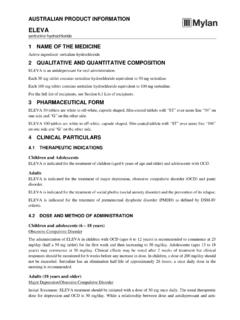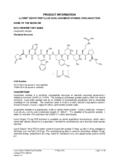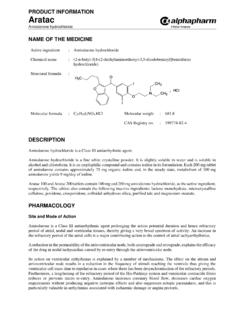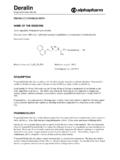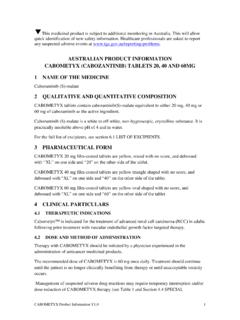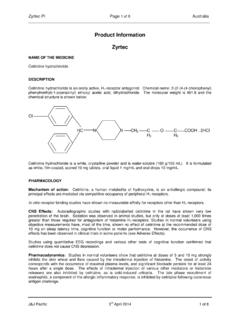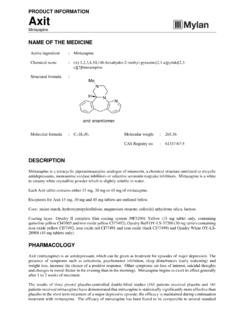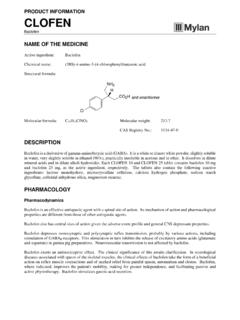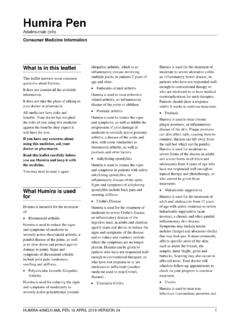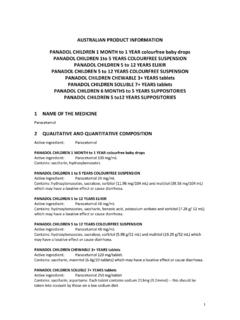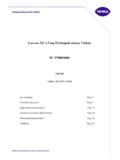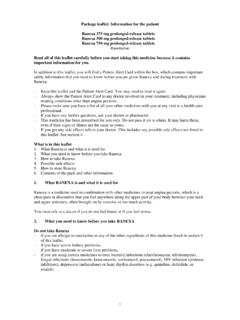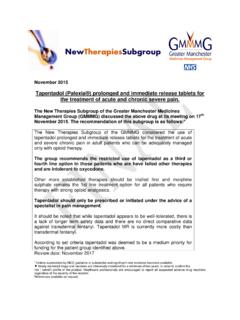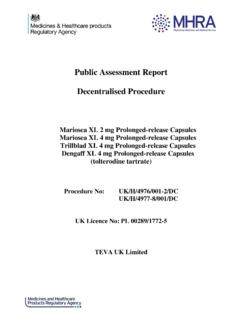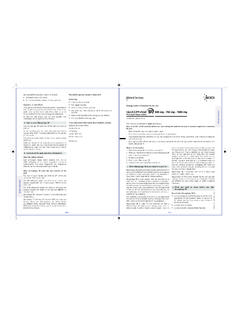Transcription of AUSTRALIAN PRODUCT INFORMATION BETMIGA …
1 1 PRODUCT INFORMATION BETMIGA prolonged - release film - coated tablets NAME OF THE MEDICINE Active ingredient: mirabegron Chemical structure: Chemical name: 2-(2-amino-1,3-thiazol-4-yl)-N-[4-(2-{[( 2R)-2-hydroxy-2-phenylethyl]amino}ethyl) phenyl]acetamide Molecular formula: C21H24N4O2S CAS registry number: 223673-61-8 DESCRIPTION Mirabegron is white to off-white crystals or powder. It is freely soluble in dimethyl sulfoxide, soluble in methanol and insoluble in water. The dissociation constant (pKa) is and BETMIGA contains mirabegron 25 mg or 50 mg as the active ingredient. BETMIGA is available as prolonged - release film - coated tablets for oral administration. The tablets are presented as the following: 25 mg: an oval, brown film - coated tablet, debossed with the (Astellas logo) and 325 50 mg: an oval, yellow film - coated tablet, debossed with the (Astellas logo) and 355 BETMIGA contains the following excipients: macrogols, hyprolose, butylated hydroxytoluene, magnesium stearate, hypromellose, iron oxide yellow, and iron oxide red (25 mg tablet only).
2 PHARMACOLOGY Mechanism of Action Mirabegron is an agonist of the human beta 3-adrenoceptor (AR) as demonstrated by in vitro laboratory experiments using the cloned human beta 3-AR. Although mirabegron showed very low intrinsic activity for cloned human beta 1- and beta 2-AR, results in humans indicate that 2 some beta 1-AR stimulation occurs at mirabegron doses of 50 to 200 mg. Mirabegron showed relaxation of bladder smooth muscle in rat and human isolated tissue, increased cAMP concentrations in rat bladder tissue and showed a bladder relaxant effect in rat urinary bladder function models. Mirabegron increased mean voided volume per micturition and decreased the frequency of non-voiding contractions, without affecting voiding pressure, or residual urine in rat models of bladder overactivity.
3 In a monkey model, mirabegron showed decreased voiding frequency. These results indicate that mirabegron enhances urine storage function by stimulating beta 3-AR in the bladder. During the urine storage phase, when urine accumulates in the bladder, sympathetic nerve stimulation predominates. Noradrenaline is released from nerve terminals, leading predominantly to beta adrenoceptor activation in the bladder musculature, and hence bladder smooth muscle relaxation. During the urine voiding phase, the bladder is predominantly under parasympathetic nervous system control. Acetylcholine, released from pelvic nerve terminals, stimulates cholinergic M2 and M3 receptors, inducing bladder contraction. The activation of the M2 pathway also inhibits beta 3-AR induced increases in cAMP.
4 Therefore beta 3-AR stimulation should not interfere with the voiding process. This was confirmed in rats with partial urethral obstruction, where mirabegron decreased the frequency of non-voiding contractions without affecting the voided volume per micturition, voiding pressure, or residual urine volume. Pharmacodynamic Effects Urodynamics Mirabegron at doses of 50 mg and 100 mg once daily for 12 weeks in men with lower urinary tract symptoms (LUTS) and bladder outlet obstruction (BOO) showed no effect on cystometry parameters and was safe and well tolerated. The effects of mirabegron on maximum flow rate and detrusor pressure at maximum flow rate were assessed in an urodynamic study consisting of 200 male patients with LUTS and BOO. Administration of mirabegron at doses of 50 mg and 100 mg once daily for 12 weeks did not adversely affect the maximum flow rate or detrusor pressure at maximum flow rate.
5 Effect on QT Interval Mirabegron at doses of 50 mg or 100 mg had no effect on the QT interval individually corrected for heart rate (QTcI interval) when evaluated either by sex or by the overall group. A thorough QT (TQT) study (n = 164 healthy male and n = 153 healthy female volunteers with a mean age of 33 years) evaluated the effect of repeat oral dosing of mirabegron at the indicated dose (50 mg once daily) and two supra-therapeutic doses (100 and 200 mg once daily) on the QTcI interval. The supra-therapeutic doses represent approximately and the exposure of the therapeutic dose, respectively. A single 400 mg dose of moxifloxacin was used as a positive control. Each dose level of mirabegron and moxifloxacin was evaluated in separate treatment arms each including placebo-control (parallel cross-over design).
6 For both males and females administered mirabegron at 50 mg and 100 mg, the upper bound of the one-sided 95% confidence interval (CI) did not exceed 10 ms at any time point for the largest time-matched mean difference from placebo in the QTcI interval. In females administered mirabegron at the 3 50 mg dose, the mean difference from placebo on QTcI interval at 5 hours post dose was ms (upper bound of the one-sided 95% CI ms). In males, the difference was ms (upper bound of the one-sided 95% CI ms). At a mirabegron dose of 200 mg, the QTcI interval did not exceed 10 ms at any time point in males, while in females the upper bound of the one-sided 95% CI did exceed 10 ms between h, with a maximum difference from placebo at 5 hours where the mean effect was ms (upper bound of the one-sided 95% CI ms).
7 Results for QTcF and QTcIf were consistent with QTcI. In this TQT study, mirabegron increased heart rate on ECG in a dose dependent manner across the 50 mg to 200 mg dose range examined. The maximum mean difference from placebo in heart rate ranged from bpm with mirabegron 50 mg up to bpm with mirabegron 200 mg in healthy subjects. Effects on Pulse Rate and Blood Pressure in Patients with Overactive Bladder (OAB) In OAB patients (mean age of 59 years) across three 12-week phase 3 double blind, placebo controlled studies receiving mirabegron 50 mg once daily, an increase in mean difference from placebo of approximately 1 bpm for pulse rate and approximately 1 mm Hg or less in systolic blood pressure/diastolic blood pressure was observed. Changes in pulse rate and blood pressure are reversible upon discontinuation of treatment.
8 Effect on Intraocular Pressure (IOP) Mirabegron 100 mg once daily did not increase IOP in healthy subjects after 56 days of treatment. In a phase 1 study assessing the effect of mirabegron on IOP using Goldmann applanation tonometry in 310 healthy subjects, a dose of mirabegron 100 mg was non-inferior to placebo for the primary endpoint of the treatment difference in mean change from baseline to day 56 in subject-average IOP; the upper bound of the two-sided 95% CI of the treatment difference between mirabegron 100 mg and placebo was mm Hg. Pharmacokinetics Absorption After oral administration of mirabegron in healthy volunteers mirabegron is absorbed to reach peak plasma concentrations (Cmax) between 3 and 4 hours. The absolute bioavailability increased from 29% at a dose of 25 mg to 35% at a dose of 50 mg.
9 Mean Cmax and AUC increased more than dose proportionally over the dose range. In the overall population of males and females, a 2-fold increase in dose from 50 mg to 100 mg mirabegron increased Cmax and AUCtau by approximately and , respectively, whereas a 4-fold increase in dose from 50 mg to 200 mg mirabegron increased Cmax and AUCtau by approximately and Steady state concentrations are achieved within 7 days of once daily dosing with mirabegron. After once daily administration, plasma exposure of mirabegron at steady state is approximately double that seen after a single dose. Co-administration of a 50 mg tablet with a high-fat meal reduced mirabegron Cmax and AUC by 45% and 17%, respectively. A low-fat meal decreased mirabegron Cmax and AUC by 75% and 51%, respectively.
10 In the phase 3 studies, mirabegron was administered with or without 4 food and demonstrated both safety and efficacy. Therefore, mirabegron can be taken with or without food at the recommended dose. Distribution Mirabegron is extensively distributed. The volume of distribution at steady state (Vss) is approximately 1670 L. Mirabegron is bound (approximately 71%) to human plasma proteins, and shows moderate affinity for albumin and alpha-1 acid glycoprotein. Mirabegron distributes to erythrocytes. In vitro erythrocyte concentrations of 14C-mirabegron were about 2-fold higher than in plasma. Metabolism Mirabegron is metabolized via multiple pathways involving dealkylation, oxidation, (direct) glucuronidation, and amide hydrolysis. Mirabegron is the major circulating component following a single dose of 14C-mirabegron.
